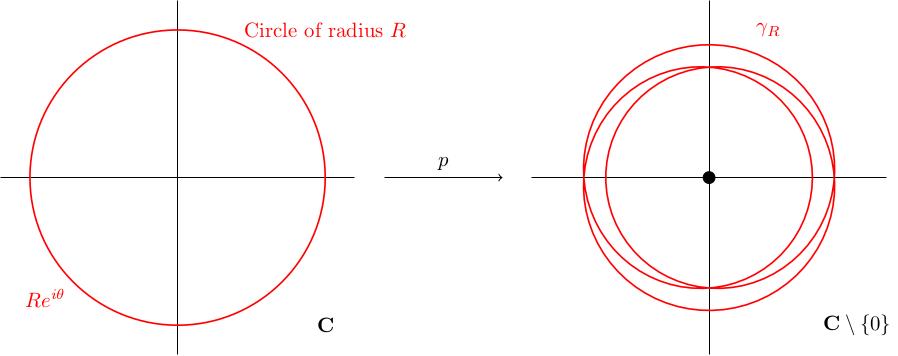1.01 Winding numbers and the fundamental theorem of algebra
Below the video you will find accompanying notes and some pre-class questions.
- Next video: 1.02 Paths, loops and homotopies.
- Index of all lectures.
Notes
(0.00) I want to start this module by giving a rough sketch of how to prove the fundamental theorem of algebra using the idea of winding numbers. You may have seen something similar in a first course on complex analysis, where the winding number was defined using a contour integral. The aim of the current proof is to remove the need for complex analysis in this definition: the winding number is something purely topological.
The fundamental theorem of algebra
(2.24) Consider the circle of radius \(R\) in the complex plane. The points in this circle are precisely those of the form \(Re^{i\theta}\). Let \(\gamma_R\) be the image of this circle under the map \(p\colon\mathbf{C}\to\mathbf{C}\). We can think of \(\gamma_R\) as a loop in \(\mathbf{C}\): \[\gamma_R(\theta)=p(Re^{i\theta}).\] Crucially, because \(p(z)\neq 0\) for all \(z\in\mathbf{C}\), the loop \(\gamma_R\) is a loop in \(\mathbf{C}\setminus\{0\}\).

(3.54) When \(R=0\), \(\gamma_0(\theta)=p(0)\) is independent of \(\theta\). In other words, \(\gamma_0\) is the constant loop at the point \(p(0)\in\mathbf{C}\setminus\{0\}\).
(4.42) When \(R\) is very large, the term \(z^n\) dominates in \(p\), so \(\gamma_R(\theta)\approx \delta(\theta)\), where \(\delta(\theta)=R^ne^{in\theta}\).
Claim: (6.54) There is a homotopy invariant notion of winding number around the origin for paths in \(\mathbf{C}\setminus\{0\}\) which gives zero for the constant loop and \(n\) for the loop \(\delta(\theta)=R^ne^{in\theta}\).
Homotopy invariant means, roughly, invariant under continuous deformations; in our situation, that means that the winding number of \(\gamma_R\) around the origin should be independent of \(R\). Since \(\gamma_0\) has winding number zero and \(\gamma_R\) has winding number \(n\) for large \(R\), this implies \(n=0\).
Outlook
(9.24) The rest of this module will be about defining this notion of winding number, the notion of homotopy and homotopy invariance, and generalising it to other spaces. In a more general setting, the spaces we're interested in (in this example \(\mathbf{C}\setminus\{0\}\)) will have an associated group (in this example the integers \(\mathbf{Z}\)) called the fundamental group and loops will have winding ``numbers'' which are elements of this group.
This will have many applications, including:
- the Brouwer fixed point theorem (any continuous map from the 2-dimensional disc to itself has a fixed point).
- the fact that a trefoil knot cannot be unknotted.
- the fact that the three Borromean rings cannot be unlinked from one
another (despite the fact that they can be unlinked in pairs
ignoring the third).
Pre-class questions
- Go through the rough sketch proof and highlight all the steps which
seem to you not to be fully justified. We will discuss this in
class, and I will call upon you for suggestions. Later in the
module, we will revisit this proof and fill in all the gaps
(hopefully to your satisfaction).
Navigation
- Next video: 1.02 Paths, loops and homotopies.
- Index of all lectures.